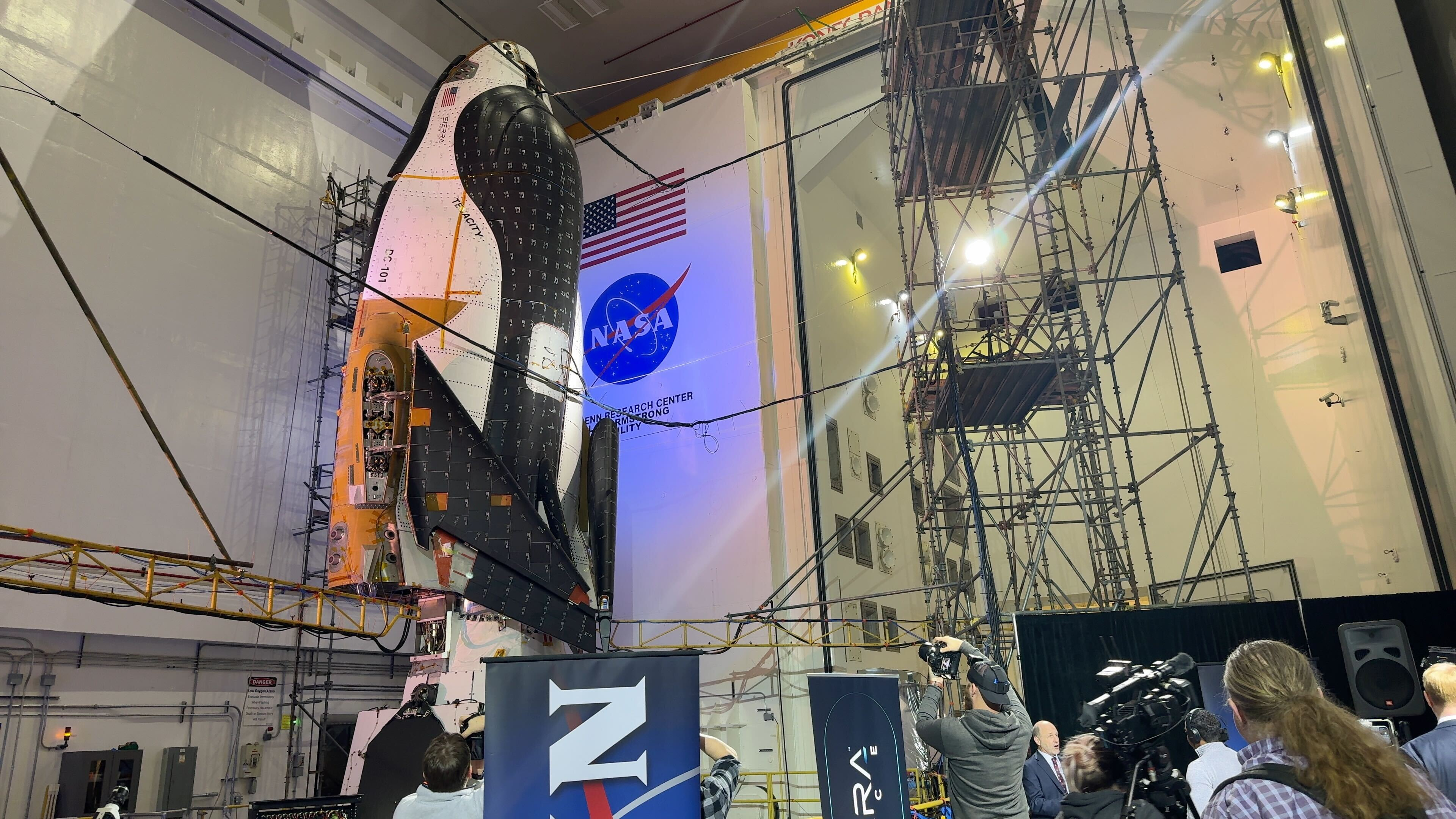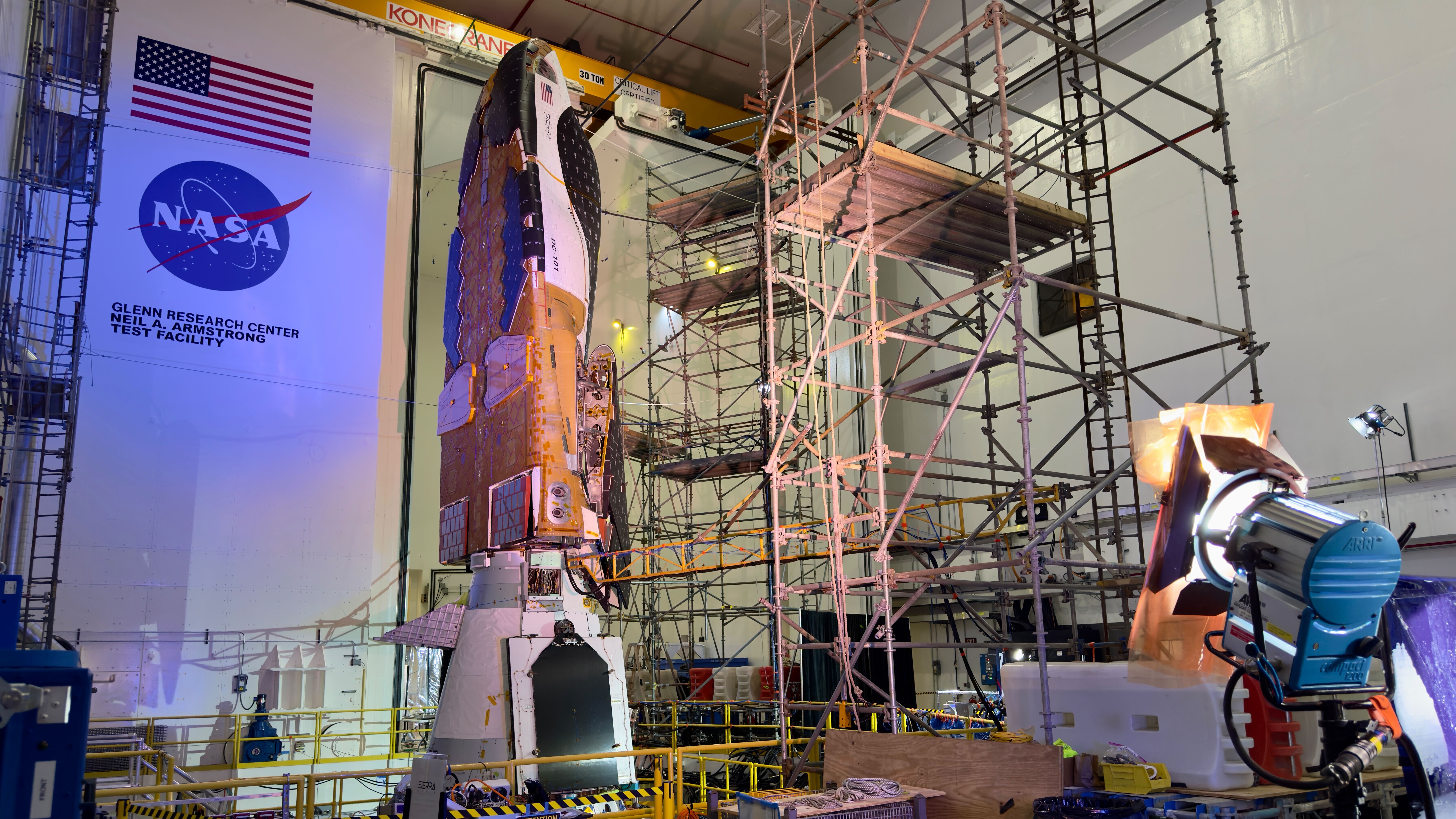Sierra Space unveils Dream Chaser space plane ahead of 1st flight to ISS (video)
We just got up-close looks at Dream Chaser at NASA's Neil Armstrong Test Facility in Ohio.
SANDUSKY, Ohio — Ohio, the home of the Wright Brothers, is known as the "Birthplace of Aviation." But the state also has some serious spaceflight bona fides, as we were reminded during an event on Thursday (Feb. 1).
On that day, NASA and the Colorado-based company Sierra Space gave reporters an up-close look at Dream Chaser, a private space plane that's scheduled to fly its first-ever mission to the International Space Station (ISS) later this year.
The event took place at NASA's Neil Armstrong Test Facility here in Sandusky. The robotic Dream Chaser and its cargo module — vehicles named "Tenacity" and "Shooting Star," respectively — were stacked vertically, as they will be during launch. The duo stood 55 feet tall (16.8 meters) — roughly the length of a school bus!
Related: Dream Chaser enters final testing ahead of 2024 debut space flight
"In order to convert bold dreams into bold action, it requires an enormous amount of tenacity, perseverance, confidence, determination and passion. And so we name our products after these emotional characteristics that get you through the hard times," Tom Vice, the CEO of Sierra Space, said during Thursday's event.
"Building Tenacity has been hard," he added. "There's been a lot of things that we've found collectively that didn't always work right the first time. And we learned a lot that Tenacity has gotten us through the last six years, so there was no other name."
Tenacity's highly anticipated debut will ferry cargo to the ISS for NASA. That uncrewed demonstration mission will help advance science in space and continue to spur a burgeoning economy in low Earth orbit.
Breaking space news, the latest updates on rocket launches, skywatching events and more!
But before the inaugural journey can begin, Tenacity and Shooting Star must complete a variety of tests. That's what's happening here in Sandusky: The spacecraft are being put through their paces at the NASA center's Mechanical Vibration Facility. These trials expose the vehicles to the various harsh environments they'll experience on a mission, such as the jarring they'll get during launch, which will occur atop a United Launch Alliance Vulcan Centaur rocket.
"All the testing we've done over the last six years as well developmental testing, all the autonomy and aerodynamics — the remaining testing is the environmental testing of what the vehicle will actually see on the launch pad during the Vulcan ride up," Vice said on Thursday. "The testing is associated with replicating the environment of space, the vacuum of space; that's going to be done in the thermal vac chamber."
Sierra Space received a Commercial Resupply Services-2 (CRS2) multi-year contract from NASA in 2016, to provide at least six ISS cargo delivery missions. According to a recent release from NASA, this is part of an ongoing effort to increase the options of commercial resupply in low Earth orbit.
NASA continues to team up with U.S. private industry when it comes to transporting cargo and astronauts to the station. For example, the agency signed commercial crew deals with Boeing and SpaceX back in 2014. Elon Musk's company has already launched seven operational crewed missions to the ISS and is gearing up for number eight. (Boeing, on the other hand, aims to launch the first crewed test flight of its Starliner capsule this spring.)
The growing involvement of private players in ISS resupply could boost science returns in a big way down the road, NASA officials and exploration advocates say.
"They're continuing the lifeline for the research in zero g that the ISS is doing now and that we hope to do for the future, and we're talking about new materials," former NASA astronaut Tom Marshburn, who's now Sierra Space's chief medical officer, said on Thursday.
"A lot of people don't realize that the cytoskeletal structure of both human cells and bacteria actually changes in weightlessness and changes how they react," he added. "NASA has been able to develop new vaccines, crystal growth, all kinds of things you can do in weightlessness. I think we are just at the first few footsteps in a brand-new world with what we are going to be able to do once we start flying."
While Shooting Star will hold true to its name and burn up in Earth's atmosphere after its one and only mission is done, Tenacity will land and be prepped for another liftoff. Indeed, the space plane is designed to fly up to 15 missions.
Tenacity will carry more than 7,800 pounds (3,540 kilograms) of cargo on its first flight, though it could tote up to 11,500 pounds (5,215 kg) on future missions. The space plane is designed to bring home more than 3,500 pounds (1,590 kg) of cargo and experiment samples, while more than 8,700 pounds (3,950 kg) of garbage can be disposed of in the cargo module on reentry.
Related: Meet 'Tenacity': 1st Dream Chaser space plane gets a name
Dream Chaser's builders aimed to create something both very reusable and very reliable.
"If we're a company that wants to benefit life on Earth, we want to understand what the impact is on it," Vice said. " And so we designed this vehicle to use even a very special fuel; it's hydrogen peroxide and refined kerosene, so that we don't use really hazardous materials. And so it's very unique — we think the ability to fly multiple times on a single vehicle allows us to have a smaller footprint every time we fly."
Launch of Tenacity and Shooting Star is currently targeted for the first half of this year, from Space Launch Complex 41 at Cape Canaveral Space Force Station in Florida. After liftoff, teams from Sierra Space's Dream Chaser Mission Control Center in Louisville, Colorado, NASA's Kennedy Space Center in Florida, and NASA's Johnson Space Center in Houston will work together to monitor the flight, control the spacecraft, and make in-orbit demonstrations to help certify the system for future missions.
"The research that's done on space station is tremendous, but broader than that, the learning of this huge community is increasing our ability to travel to and from space and learn from it," Phil Dempsey, transportation integration manager for NASA's International Space Station Program, said during Thursday's event.
"There are people sitting at home, you ask them a question — why should I go do that, why should our tax dollars go to that? It's not so much for any one individual reason, but the learning that we have as an industry and as mankind because of space travel and the difficulty of space travel," Dempsey said. "It contributes to what we can do as an overall group of people here on the Earth as we look to do things off the Earth, or enhance work on the Earth or research that benefits us."
Editor's note: This story was updated on Feb. 7 to correctly identify who said the first quote ("In order to convert bold dreams...."). It was Tom Vice, not Tom Marshburn as originally stated.

Meredith is a regional Murrow award-winning Certified Broadcast Meteorologist and science/space correspondent. She most recently was a Freelance Meteorologist for NY 1 in New York City & the 19 First Alert Weather Team in Cleveland. A self-described "Rocket Girl," Meredith's personal and professional work has drawn recognition over the last decade, including the inaugural Valparaiso University Alumni Association First Decade Achievement Award, two special reports in News 12's Climate Special "Saving Our Shores" that won a Regional Edward R. Murrow Award, multiple Fair Media Council Folio & Press Club of Long Island awards for meteorology & reporting, and a Long Island Business News & NYC TV Week "40 Under 40" Award.


